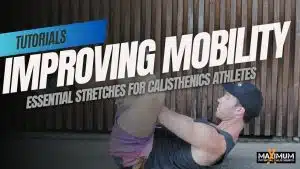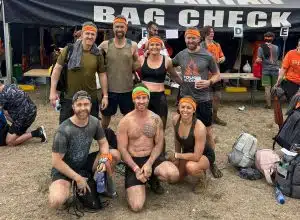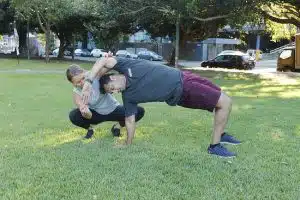Most of the lessons we learn are from experience.
I would love to go back in time and give my younger self some advice, but unfortunately, that can’t be done.
What I can do however is share the lessons I’ve learned from mistakes I’ve made myself, and have
seen others make too, in the hope that these tips will help you progress faster on your Calisthenics
journey.
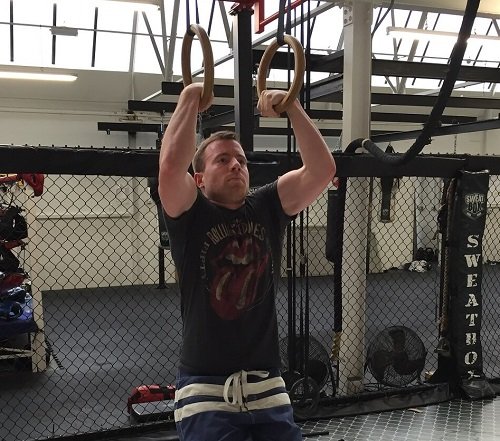
1. Avoid bad form to prevent getting into bad habits
There are many calisthenics exercises which beginners struggle with initially, and often people find
themselves using bad form or improper technique to complete the exercises.
The person may feel like they have accomplished something new, but instead, they have just ended
up cheating themselves out of learning the exercise properly and are much more likely to get an
injury.
What’s worse is that bad form is very hard to get rid of. Trust me on that one.
Take the Muscle-up for example.
When starting out, many people will use a swinging ‘kipping’ motion to get their first Muscle-up.
Others may swing less, but because they still lack the power to get over the bar fully, they end up
swinging one arm over the bar first and then follow with the second arm. This is known in the industry
as a “Struggle-up”.
It’s important when starting out with Calisthenics that you take the time to work through exercises
properly and focus on proper form. This can be done by following easier progressions of the
exercises or using assistance to complete the exercise properly.
In the above example, yes it may take longer to get your first Muscle-up but be patient. Keep your
arms and body symmetrical, and you’ll be thankful later!
2. Work in progressions to achieve the full exercise
Getting inspiration from places like Instagram can be a great thing, but I think the problem with that
is you often only see the perfect, advanced level exercises and miss the less appealing progressions
that the athlete may have worked through to get to that level.
Take Front or Back Levers for example as exercises that look fantastic when performed perfectly.
When learning these exercises, you shouldn’t just expect to jump up onto the bar and execute a
perfectly horizontal Lever straight away.
Instead, you’ll need to work your way through the various progressions, such as having your legs
tucked, extending one leg, or straddling your legs, for example, rather than trying to jump straight
into a perfect Lever.
This is one area where bodyweight exercises are much different from pushing weights in the gym.
With a barbell chest press, for example, you can simply start with the lowest weight you can push,
and then simply add a few Kgs of weight to the bar as you get stronger.
With Calisthenics, it isn’t as simple as that and therefore we need to use progressions to break down
a hard bodyweight exercise that we cannot achieve yet.
One of the best ways to get around this is to purchase a set of Resistance Bands.
You may know many people who use resistance bands as part of their workout to make an exercise
harder, but with calisthenics, we can use the bands as an assistance in order to hold some of our
body weight.
I’d recommend purchasing a mix of different resistance bands and start by using a stronger
resistance band, then work your way to completing the exercise with the lighter resistance bands,
until you can complete the exercise without the need to use a resistance band at all.
3. Don’t just workout in your own home
I’ve always struggled to exercise on my own.
For some people, that’s the only way they workout; at home, by themselves.
When I talk to these people though I find they often struggle with the same problems:
-
- Their workout is stale
- They’re uninspired
- They’re not progressing as fast as they had originally hoped for
Don’t get me wrong, working out at home is a great way to supplement your regular training, but a
lot of technique, ideas, and motivation is best taught by a calisthenics trainer at a class.
I love attending a calisthenics class, as working as a group pushes you through the right exercises at
a good pace, and you can see others around you improving.
It’s also fantastic for motivation, as there are some days I feel like I lack the energy and would usually
throw the towel in within 20 minutes of working out.
On the flipside, there may be people reading this who never workout at home and their training may
not be progressing as fast as it could be because they aren’t making use of their spare time as much
as they could be.
If you have space at home, it is absolutely worth investing in a solid free-standing pull-up bar, as this
can turn your home into a second gym, and allow you to continue to train at home in your own time.
4. Look after your hands and let them toughen up naturally
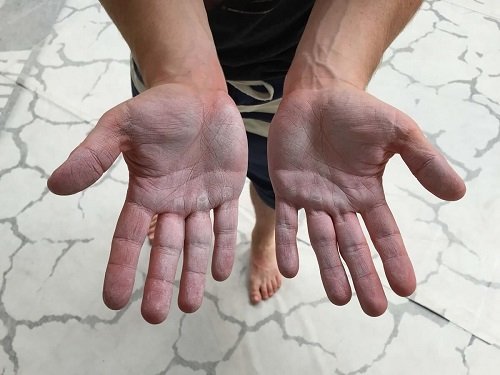
One thing that surprises everyone at first is how tough Calisthenics can be on your hands, especially
as calluses can form on the inside of your hands.
Many people want to buy a pair of gloves when starting out to protect their hands, but using gloves
only stops your hands from toughening up naturally.
Gloves can, of course, be useful occasionally if you need to give your hands a short break, but it’s
bad to always rely on them as your hands will remain soft and won’t toughen up all the time.
When calluses do form, it is important to care for them properly, so they don’t build up and rip. To
do this, you should regularly soak your hands in warm water to soften the skin around the calluses
and use a pumice stone to remove the dead skin once it has softened.
As an extra tip: If you’re struggling with your grip then I’d recommend grabbing yourself a climber’s
chalk ball. The can be found online for a very low price.
5. Don’t underestimate the importance of Wrist flexibility
I hate the word flexibility.
I was never good at yoga and the effort needed to ‘become flexible’ never felt like it was worth it to
me.
But my one exception to that rule is wrist flexibility.
When training Calisthenics (especially the more difficult exercises), you’ll quickly see how important
flexible wrists are.
Handstands, Planche, False-grip Muscle-ups / Pull-ups are just a few examples of exercises which
you need strong and healthy wrists to complete with proper form.
It doesn’t matter how strong you are, you simply won’t be able to progress with these kinds of
exercises if your wrists are weak and inflexible, so I strongly recommend you put a small amount of
time aside to regularly work on strengthening your wrists.

